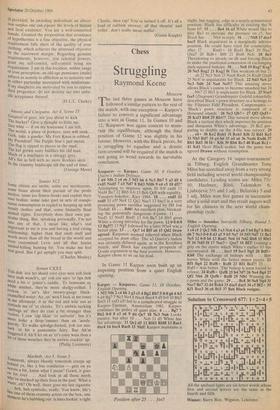Chess
Struggling
Raymond Keene
Moscow he last three games in Moscow have followed a similar pattern to the rest of the match, with one exception — Karpov's failure to convert a significant advantage into a win in Game 11. In Games 10 and 12, Kasparov was again content to main- tain the equilibrium, although the final position of Game 12 was slightly in his favour. However, with the Black pieces, he is struggling to equalise and a drastic turn-around will be required if the match is not going to wend towards its inevitable conclusion.
Kasparov — Karpov: Game 10, 8 October; Queen's Indian Defence.
I d4 Nf6 2 c4 e6 3 Nf3 b6 4 Nc3 Bb7 5 a3 d5 6 cxd5 Nxd5 7 e3 Nd7 8 Bd3 N5f6 9 e4 c5 10 d5!? Attempting to improve upon 10 0-0 cxd4 11
Nxd4 Be7 12 Bb5 0-0 13 Bc6 Qc8 with equality, Yusupov-Sokolov, Kiev 1984. 10 . . . exd5 11 exd5 11 e5! Ne4 12 Qe2 Nxc3 13 bxc3 is a very promising pawn sacrifice suggested by 1M Jon Tisdall. 11 . . . Bd6! An excellent plan, blockad- ing the potentially dangerous d-pawn. 11 . . . Nxd5 12 Nxd5 Bxd5 13 0-0 Be7 14 Bb5 gives White a strong initiative for the pawn. 12 0-0 0-0 13 Bg5?! 13 Ng5 followed by a later N5e4 was a better plan. 13 . . . Qc7 14 BfS a6 15 Qd2 Draw agreed. Kasparov seemed relieved when Black accepted his draw offer. The a3 Queen's Indian was certainly defused again, as in the Korchnoi match, and Black has excellent prospects of 0-side expansion in the final position. However, Karpov chose to sit on his lead.
In Game 11 Karpov soon built up an imposing position from a quiet English opening.
Karpov — Kasparov: Game 11, 10 October; English Opening. 1 Nf3 Nf6 2 c4 b6 3 g3 c5 4 Bg2 Bb7 5 0-0 g6 6 b3 6 d4 Bg7 7 Nc3 Ne4 8 Nxe4 Bxe4 9 d5 0-0 10 Bh3 Bxf3 11 exf3 e5! led to a complicated struggle in Karpov-Timman, Amsterdam 1981. Karpov continues his policy of quiet play. 6 . . . Bg7 7 Bbl 0-0 8 e3 e6 9 d4 Qe7 10 Nc3 Na6 Looks passive, but after 10 . . . Nc6 11 d5 White has the advantage. 11 Qe2 d5 12 Rfdl Rfd8 13 Racl dxc4 14 bxc4 Rac8 15 Nb5! Karpov maintains a
Position after 25 . . . fxe5
slight, but nagging, edge in a nearly symmetrical position. Black has difficulty in evicting the N from b5. 15 . . . Be4 16 a3 White would like to play Ba3 to increase the pressure on c5, but Black has . . . Nb4 in reply. 16 . . : Nb8 17 dxc5 bxc5 Black acquiesces in a marginally inferior position. He could have tried for counterplay after 17 . . . Rxd 1 + 18 Rxdl Rxc5 19 Nxa7 Qxa7 20 Rd8+ Bf8 21 Bxf6 Nc6. 18 Be5 Threatening to invade on d6 and forcing Black to make the positional concession of exchanging dark-squared bishops. 18 . . . Ne8 19 Bxg7 Kxg7 20 Ne5 Bxg2 21 Kxg2 16 This weakens e6 but 21 . . . a6 22 Nc3 Nc6 23 Nxc6 Rxc6 24 Rxd8 Qxd8 25 Ne4! is unpalatable for Black. 22 Nd3 Nc6 23 Nc3 Nd6 24 Na4 Ne5!? This amazing move allows Black's pawns to become smashed but 24 . . Nb7 25 Rbl is unpleasant for Black. 25 NxeS fxe5 (Diagram) Grandmaster Gufeld colourfully described Black's pawn structure as a homage to the Filipinio Fide President, Campomanes 'Black's pawn structure is composed of a thousand islands.' 26 Nc3 Qb7+ 27 Qf3 Qxf3+ 28 Kxf3 Rb8 29 Rbl?! This natural move allows Black a tactical shot which improves his position and dissipates White's advantage. 29 Rc2 pre- paring to double on the d-file was correct. 29 . . . e4+ 30 Ke2 Rxbl 31 Rxbl Kf6 32 Rdl Ke5 33 Nb5 Rd7 34 g4 h6 35 a4 a6 36 Nxd6 Rxd6 37 Rbl Rd3 38 f4+ Kf6 39 Rb6 Rc3 40 Rxa6 Rc2+ 41 Kdl Here Black sealed, but the game was agreed Drawn without resumption.
At the Category 14 'super-tournament' at Tilburg, English Grandmaster Tony Miles has scorched away from a very strong field including several world championship candidates. Leading scores are: Miles 71/2/ 10; Huebner, Ribli, Tukmakov 6; Ljubojevic 51/2 and 1. adj.; Beliaysky 5 and 1 adj. Miles won five games in succession after a solid start and this result augurs well for his chances in the next world cham- pionship cycle.
Miles — Sosonko: Interpolis Tilburg, Round 5; English Opening.
1 c4 e5 2 Qc2 Nf6 3 e3 Nc6 4 a3 g6 5 b4 Bg7 6 Bb2 d6 7 Nc3 0-0 8 d3 a5 9 b5 Ne7 10 Nf3 Nd7 11 Be2 Nc5 12 0-0 b6 13 Radl Ne6 14 Nd2 Rb8 15 Rfel 15 16 Nd5 f4 17 Nxe7+ Qxe7 18 Bf3! Gaining a grip on the centre which White's earlier b5 has accentuated. 18 . . . fxe3 19 fxe3 Ng5 20 BdS+ Kh8 The exchange of bishops with . . . Be6 leaves White with the better minor pieces. 21 Rfl Bg4 22 RxfS+ Rxf8 23 Rfl Be2?! 23 . . . Rxfl + was better. The bishop is soon forced to retreat. 24 Rxf8+ Qxf8 25 h4 Nf7 26 Ne4 Bg4 27 Q12 Nh6 28 Qxf8+ Bxf8 29 Nf6! Winning the c-pawn and the game. 29 . . . Bc8 30 Ne8 Ng4 31 Nxc7 Be7 32 d4 Bxh4 33 dxe5 dxe5 34 c5 Bf2+ 35 Kfl Bxe3 36 c6 Bc5 37 Be6 Black resigns.


















































 Previous page
Previous page